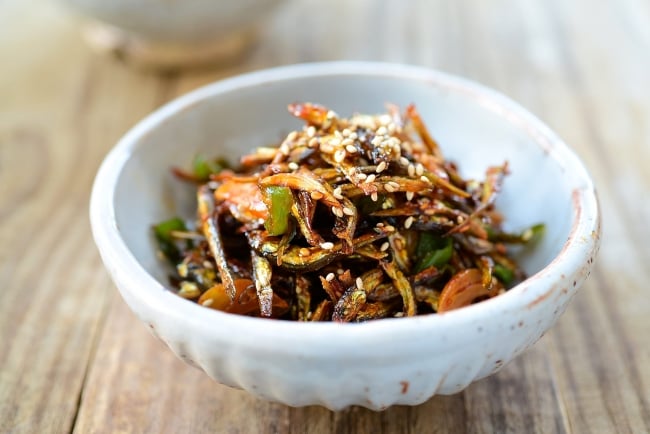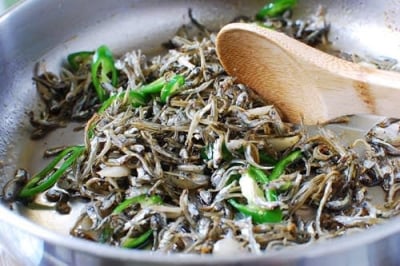Myeolchi bokkeum (or myulchi bokkeum) is a popular side dish (banchan) in Korea. The stir-fried anchovies are sweet, savory, sticky and crunchy! This easy recipe also shows how to make it a bit spicy.

Myeolchi bokkeum (멸치볶음), stir-fried dried anchovies, is a staple side dish in Korea. It’s one of the most common basic side dishes, called mitbanchan (밑반찬). Basic side dishes are made to last long and served with every meal, including home-packed school lunch boxes. Korean stir-fried anchovies are sweet, savory, sticky and crunchy! This recipe shows two ways to prepare myulchi bokkeum – mild and spicy.
Korean dried anchovies
As explained in my Anchovy Stock for Korean Cooking post, dried anchovies (myeolchi or myeolchi, 멸치) come in a wide range of qualities and sizes. If you visit traditional markets in Korea, you can easily find big piles of different sizes of dried anchovies on display everywhere. Buy the best quality anchovies you can find. These anchovies are a staple in my freezer. Dried anchovies are best kept in the freezer.
Medium to large anchovies are primarily used to make broth, gukmul yong (국물용). Smaller ones are used for various stir-fried or braised side dishes and usually labeled bokkeum yong (볶음용). The smallest, tiny anchovies are called jiri myulchi (지리멸치). You can use any small dried anchovies for this recipe.
Anchovies are high in nutrition, so Korean moms encourage their kids to eat more anchovies. They are an excellent source of calcium, protein, Omega 3 fat, etc. My kids didn’t favor them when they were little, but they both eventually acquired the taste. Now, these stir-fried anchovies are among the regular side dishes I prepare to bring with me when I visit them.
How to make myeolchi bokkeum
You don’t need to remove the guts and/or the heads from small anchovies before using them. They are all edible. If you are sensitive to a fishy taste, you can pan-fry the anchovies for a couple of minutes in a heated dry pan before using them. This will remove some of the fishy taste.
To make myulchi bokkeum, stir-fry the dried anchovies in a little bit of oil, and then mix them in a thickened sweet and savory sauce. You can give them a spicy kick by using some gochujang (Korean red chili pepper paste). Dried anchovies are naturally salty, so don’t over season them.
This myulchi bokkeum recipe was originally posted in September 2011. I’ve updated it here with an improved recipe, more information, and new photos.
More basic banchan dishes
Kongjang (Soy Braised Black Soybeans)
Ojingeochae Muchim (Spicy Dried Squid Strips)
Yeonguen Jorim (Soy Braised Lotus Roots)
Ueong Jorim (Braised Burdock Root)
Watch how to make it
For more Korean cooking inspirations, follow along on YouTube, Pinterest, Twitter, Facebook, and Instagram.

Ingredients
- 3 ounces (1 cup packed) small size myeolchi 멸치, (dried anchovies)
- 1 tablespoon cooking oil
- 2 green chili peppers cut into small pieces (optional)
Sweet and Savory:
- 1/2 tablespoon soy sauce
- 2 tablespoons rice wine or mirin
- 2 teaspoons sugar (or less to taste)
- 1 tablespoon Oligo syrup or corn syrup (or honey) Honey is sweeter so use less
- 3 plump garlic cloves (or more)
- 1 teaspoon sesame oil
- 1 teaspoon sesame seeds
Sweet and Spicy:
- 1/2 tablespoon gochujang Korean red chili pepper paste
- 1 teaspoon gochugaru (optional) Korean red chili pepper flakes
- 2 tablespoons rice wine or mirin
- 2 teaspoons sugar (or less to taste)
- 1 tablespoon Oligo syrup or corn syrup (or honey) Use less if using honey
- 3 Plump garlic cloves thinly sliced
- 1 teaspoon sesame oil
- 1 teaspoon sesame seeds
Instructions
- Heat a pan with the oil over medium heat. Add the anchovies and stir fry for 2 - 3 minutes. Turn off the heat. Transfer to a plate.
- Add the seasoning ingredients, except sesame oil and seeds, to the pan. If using the spicy version, stir the sauce well to dissolve the gochujang. Turn the heat back on. Boil the sauce over medium heat until it bubbles up and slightly thickens.
- Add the anchovies and the optional chili peppers to the pan. Stir well until the anchovies are coated well with the sauce. Stir in the sesame oil and sesame seeds at the end.




























